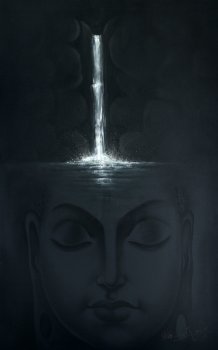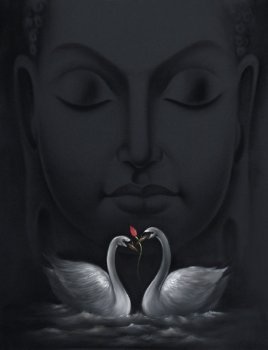
|   |

|   |
From Divine Light to Divine Darkness - Padma Jayaraj e-mail: padmajayaraj@gmail.com Photos courtesy: Prince Chand November 5, 2012 The painting exhibition DIVINE DARK (Jehangir Art Gallery, Mumbai, Oct 10 15, 2012) is a milestone in the trajectory of the artist Prince Chand, in search of light. For the artist, known for his Divine Light paintings, the shift in theme as well as the choice of colour is a turning point. The very name of the series sounds like a contradiction. But, truth often resides in the heart of contradictions. The study that features the Buddha either in the focus or in the background is done in shades of deep grey and the colour connotes different levels. Dark stands for mystery, darkness as the womb that carries light. The figures are reminiscent of the temple art of rock-cut caves in ancient India. Here is a contemporary effort to transform age old cultural technique both in form and theme as if what is contemporary were renewal of our hoary tradition. The exhibition is dedicated to the memory of an art lover, late Kantilal Gala who provided space for Prince Chand, a self taught artist, in his gallery. It began with a dream I had once of the Buddha standing on a river with light passing through his body... Ever since, for the past 12 years, I have been trying to capture light and ended up with creating the Buddha images, the artist recalls. Those 12 years for the artist was a period of study as well: reading of the Buddhist lore and visiting cave temples like the Ajanta and Ellora. The period saw experiments with colours too that finally decided in the binary dark and light. Each canvas in the upstairs hall of the gallery was a mesmerizing depiction of the Buddha....each a different metaphor, linked with nature or suggestive of myths or age-old thoughts.




The painting of the two snow white swans with the lotus bud in their midst, the Buddha head like a shadow in the background, sets the tone and tenor of the series, with the ancient philosophical text embedded into the paintings. Oil on canvas, the god-head of the Buddha is seen as a reflection in refracted turbulent waters. In greyish white and black, the painting depicts the power of spirituality over the churning of the mind and thoughts. The doves, with the Buddha in the background, is the message of peace, while the painting of the book in front of the Buddha image depicts the wisdom and legacy that he left behind for humanity. The Buddha seated in meditation with light falling from behind is a picture of serenity itself. The tree in different forms as part of the god-head recalling the Bodhi tree is a recurring feature in the series, hinting at Enlightenment. At another level it stands for nature where the Buddha is an earthly replica of a fused whole. The waterfall that remains becalmed in the lake holding the Buddha image in its undercurrents is one of the rare renderings, where nature is divinity itself. In Sanchi, the pictorial plain depicted is like the unfolding of a scroll. The concentric circle on the forehead of the Buddha image recalls Sanchi. At another level it depicts the spiritual journey beyond the whirlpool of the conscious and the subconscious mind. It is the path of Nirvana and meditation is the only tool that ancient India has forged. The waterfall recalls the Ganga captured in the matted hair of Lord Shiva. Krishna, the lord of love with his flute, the unheard melody filling the hearts, in the foreground, sends the message of love. The crown of the Buddha with raindrops frozen in time is one of the most enchanting pictures in the exhibition. In a contrasting way it recalls the gory head of Jesus Christ with droplets of blood oozing, which has reinforced an ancient guilt that crucified the Son of God. But, here, the rain drops on the serene face lost in meditation are the symbol of Pantheism superimposed on Buddhism. Divine Dark is a narrative in pictorial language. The stories evoked reveal themselves to have a deeper meaning in each re-telling, if only we could re-imagine the way in which we choose to encapsulate them. Padma Jayaraj is a freelance writer and a regular contributor to narthaki.com |